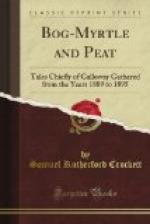“And where is that Dictionary of National Biography?” asked John Arniston of the boy. The precious letter for which he had risked penal servitude and the cat in the prisons of his country for robbery of the Imperial mails (accompanied with violence), was blazing on the fire. Then, with professional readiness, John Arniston wrote a column and a half upon the modern lessons to be drawn from the fact that Queen Anne was dead. It was off-day at the paper, Parliament was not sitting, and the columns opposite the publishers’ advertisements needed filling, or these gentlemen would grumble. The paper had a genuine, if somewhat spasmodic, attachment to letters. And from this John Arniston derived a considerable part of his income.
When he went back to his room he found that his landlady had been in attending to the fire. She had also lifted the fallen Bible, on which he could now look with some complacency—so strange a thing is the conscience.
On the worn hair covering of the old Bible lay a letter. It was from Miriam—a letter written as hastily as his own had been, with pitiful tremblings, and watered with tears. It told him, through a maze of burning love, among other things that she had been a wicked woman to listen to his words—and that while her husband lived she must never see him again. In time, doubtless, he would find some one worthier, some one who would not wreck his life, as for one mad half-hour his despairing Miriam had been willing to do. Finally, he would forgive her and forget her. But she was his own—he was to remember that.
In half an hour John Arniston was at the mortuary. Of course, he found a pressman there with a notebook before him. With him he arranged what should be said the next morning, and how the inquest should be reported. There was no doubt about the identity, and John Arniston soon possessed the proofs of it. But, after all, there was no need that the British public should know more than it already knew, or that the name of Miriam Gale should be connected with the drowned wretch, whose soddenly friendly leer struck John Arniston cold, as though he also had been in the Thames water that night.
So all through the darkness he paced in front of the house of the Beloved. His letter to her, written on leaves of his notebook, in place of that which he had destroyed, went in with the morning’s milk. In half an hour after he was with her. And when he came out again he had seen a wonderful thing—a beautiful woman to whom emotion was life, and the expression of it second nature, running through the gamut of twenty moods in a quarter of an hour. At the end, John departed in search of a licence and a church. And Miriam Gale put her considering finger to her lip, and said, “Let me see—which dresses shall I take?”
The highway robbery was never heard of. The excellent plaster which John Arniston left in the hand of the official had salved effectively the rude constriction of his throat, where John’s right hand had closed upon it.




